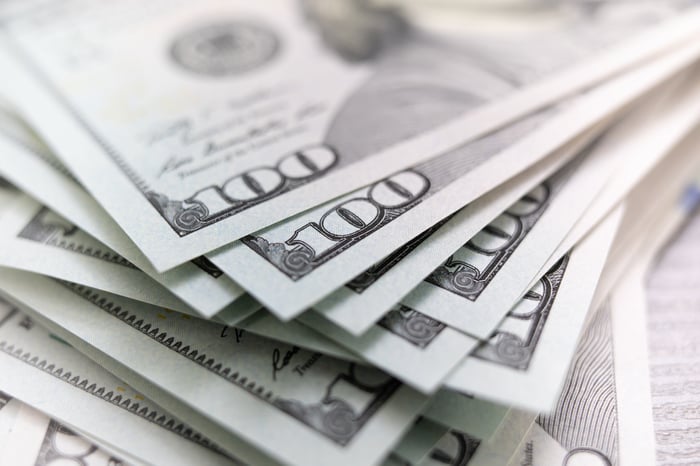Ready or not, a stock market crash is coming.
Although we'll never know precisely when a crash will occur, how long it'll last, how steep the decline will be, or (in many instances) what the catalyst for the decline will be, history shows that crashes and corrections are a normal occurrence. History is also pretty clear about the general time frame when these declines occur -- and it isn't good news if you're looking for this young bull market to stretch its legs.

Image source: Getty Images.
One of the biggest red flags can be seen on the valuation front. The S&P 500's (^GSPC -0.88%) Shiller price-to-earnings (P/E) ratio -- a measure of inflation-adjusted earnings over the previous 10 years -- closed this past week at 37.28. For reference, that's more than double the average S&P 500 Shiller P/E dating back to 1870.
The concern is that in the previous four instances where the S&P 500's Shiller P/E ratio topped and sustained 30, the index went on to lose at least 20% not long thereafter. Precedent suggests that premium valuations like we're seeing now aren't well-tolerated for long periods of time.
History also sheds light on how the markets typically respond following a bear market bottom. At no point over the past 60 years has there been a bear market that didn't correct between 10% and 19.9% at least once within three years of hitting a bottom. We're now more than 14 months removed from the March 2020 bottom and have yet to see a double-digit percentage retracement in the benchmark S&P 500.
Additionally, stock market crashes and steep corrections are commonplace on Wall Street; they're the price of admission to one of the world's greatest wealth creators. Since 1950, we've witnessed 38 double-digit declines, or one every 1.87 years, on average. Wall Street is never going to precisely follow averages, but it does offer a reference point that declines are normal.

Image source: Getty Images.
Here's where to invest $10,000 when the next stock market crash occurs
However, just because a stock market crash is inevitable doesn't mean you have to cower in fear or pull your money out of the market. On the contrary, every crash or steep correction in history has proved to be an outstanding buying opportunity for long-term investors. If you've got $10,000 at the ready that won't be needed to cover emergencies or pay bills, that's more-than-enough capital to put to work in these winning stocks when the next crash strikes.
Even though advertising-driven companies typically struggle during periods of panic selling, social-media giant Facebook (META -4.13%) has proved time and again to be the exception. When the next steep decline occurs, it would make for a genius addition to your portfolio.
As of the end of March, Facebook's namesake site brought in 2.85 billion people on a monthly basis, with another 600 million unique visitors from WhatsApp and Instagram, which it also owns. That's 3.45 billion people, or 44% of the world's population, visiting at least one of its owned assets each month. With figures like these, it's no wonder advertisers are clamoring for placement on the platform and paying sequentially higher prices to do so.
What's more, Facebook hasn't even meaningfully monetized Messenger or WhatsApp, which are two of the top social platforms in the world. The company is on pace to generate over $100 billion in sales this year, with virtually all of it coming from its namesake site and Instagram. Once Facebook begins monetizing its key assets, the company's cash flow should expand noticeably.

Image source: Getty Images.
Innovative Industrial Properties
You know what acts like a consumer-packaged good during periods of recession and panic? Cannabis. When the next stock market crash occurs, consider investing some of your $10,000 into cannabis-focused real estate investment trust (REIT) Innovative Industrial Properties (IIPR 0.37%).
In layman's terms, IIP, as the company is known, buys marijuana cultivation and processing facilities with the goal of leasing these assets out for very long periods of time (10 to 20 years). As of the end of May, IIP owned 72 properties spanning 6.6 million square feet (in aggregate) in 18 states. All 72 of these properties are leased out, with a weighted-average lease length of 16.8 years. It's going to take far less than 16.8 years for Innovative Industrial Properties to receive a complete payback on its invested capital.
The company is also thriving because of its sale-leaseback program. Since marijuana is illicit in the U.S., not all banks are willing to offer pot stocks basic banking services. To solve this, IIP acquires facilities for cash and immediately leases the asset back to the seller. This allows pot companies to bolster their balance sheets with cash while giving IIP a long-term tenant.

Image source: Getty Images.
CrowdStrike Holdings
While it may not be the fastest growth opportunity, cybersecurity is probably the safest double-digit growth trend this decade. That's why a stock market crash would be the perfect time to buy or add to cybersecurity stock CrowdStrike Holdings (CRWD -3.90%).
What allows CrowdStrike to stand out from the crowd is the company's cloud-native Falcon platform. Built entirely in the cloud and reliant on artificial intelligence, Falcon oversees approximately 5 trillion events on a weekly basis. It's becoming smarter at identifying and responding to threats over time and should be able to do so at a lower cost than on-premises security solutions.
The proof is in the pudding that CrowdStrike's customers love its services. It's been able to hang onto 98% of its customers in back-to-back years, with 63% of its clients purchasing four or more cloud-module subscriptions in the latest quarter.
For some context, that's up from just 9% who had purchased four or more cloud subscriptions less than four years ago. Since cloud subscriptions yield exceptionally high margins, CrowdStrike has already reached its long-term target of 75% to 80%+ for its subscription gross margin.

Image source: Getty Images.
Redfin
A final smart way to invest $10,000 during a stock market crash is to buy technology-driven real estate company Redfin (RDFN -2.07%).
Even though Redfin is benefiting from seemingly perfect housing-market conditions, this is a company that has legs well beyond the current housing boom.
One of the biggest lures for Redfin is the cost savings it can provide sellers. Whereas traditional real estate firms charge a 3% agent fee, Redfin charges 1% or 1.5%, depending on how much business a homeowner has done with the company. Considering how quickly home prices are rising, the savings Redfin is providing are being magnified over time.
Redfin also stands out for its personalization. The company's RedfinNow service, which is available in select cities, aims to buy homes from sellers with cash, thereby removing the least-desirable parts of the selling process. Further, the Concierge service charges up to a 2.5% fee on the sales price to help with staging and other upgrades to maximize the selling value of a home.
This personalization has likely played a big role in helping Redfin go from handling just a 0.44% share of the U.S. existing home sales market in 2015 to 1.14% in the first quarter of 2021.





